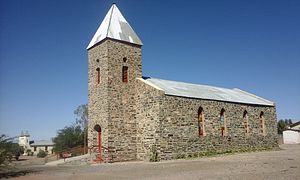Bethanie, Namibia
|
Bethanie ǀUiǂgandes Klipfontein |
|
|---|---|
| village | |

The Lentia Lutheran Church, built 1899. The village's mission church is in the background on the left.
|
|
| Location in Namibia | |
| Coordinates: 26°30′00″S 17°09′30″E / 26.50000°S 17.15833°E | |
| Country |
|
| Region | ǁKaras Region |
| Constituency | Berseba Constituency |
| Population (2012) | |
| • Total | 2,000 |
| Climate | BWh |
Bethanie (often in German: Bethanien, and in English: Bethany, previously Klipfontein, Khoekhoegowab: ǀUiǂgandes) is a village in the ǁKaras Region of southern Namibia. It is one of the oldest settlements in the country. Bethanie is situated on the road C14 between Goageb and Walvis Bay, 100 km west of Keetmanshoop. It has a population of about 2,000.
The area around Bethanie originally belonged to the Red Nation. At the beginning of the 18th century the ǃAman (Bethanie Orlam), a subtribe of the Orlam people, obtained settlement rights and settled here. As missionaries started travelling north from the Cape Colony in the early 19th century, they established mission stations on their way. The London Missionary Society founded the town, but, because of a shortage of missionaries and presumably because of the cooperation between the London and Rhenish Missionary Society at the time, they instead sent a German.
Reverend Heinrich Schmelen arrived in 1814 as missionary of the Kaiǀkhauan (Khauas Nama) and their leader Amraal Lambert. The Schmelenhaus was built the same year, long considered the oldest structure in Namibia. It is a National Monument since 1952 and serves currently as a small museum. It was later discovered that the church and the pastor's house in Warmbad, both destroyed in 1811, were older than the Schmelenhaus, and that the fortification of ǁKhauxaǃnas predates all European constructions. Schmelen also initiated the building of a chapel which was in ruins when James Edward Alexander visited the village in 1837.
...
Wikipedia

